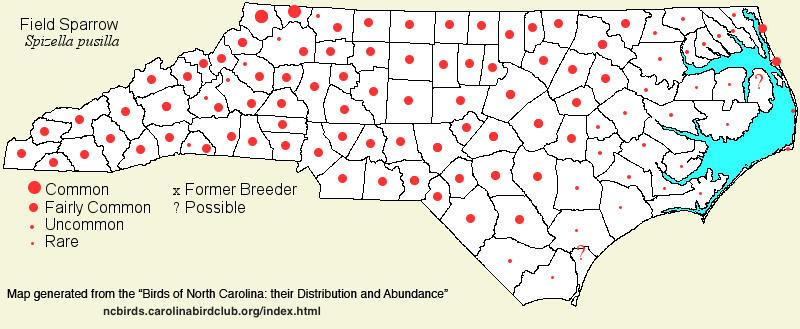 |  |
|
Field Sparrow - Spizella pusilla PASSERELLIDAE Members: | Search Common: Search Scientific: |
|
|
|||||||
| General Comments | The Field Sparrow is one of the few sparrows that breeds over essentially all of the eastern United States, from southern Canada to near the Gulf Coast. A few decades ago, this was as common a breeder in North Carolina as was the Chipping Sparrow. However, the Chipping has become very common in recent years, whereas the Field Sparrow has declined sharply, as has its habitat associate, the Northern Bobwhite. The reasons for the decline are not obvious, as most other early-succession breeders are not declining noticeably. Not surprisingly, the decline has manifested itself in winter as well, and it no longer is a common winter species in some areas, especially near the coast. Breeding habitat is primarily overgrown fields, clearcuts, maritime thickets, and woodland borders, always where there is a thick grass/herbaceous cover and scattered shrubs and saplings. In winter, the birds occur in these habitats, as well as in weedy fields (devoid of woody growth); it mixes with many other species of sparrows in winter, usually in sizable flocks. | ||||||
| Breeding Status | Breeder | ||||||
| NC BRC List | Definitive | ||||||
| State Status | |||||||
| U.S. Status | |||||||
| State Rank | S5B,S5N | ||||||
| Global Rank | G5 | ||||||
| Coastal Plain | Permanent resident, with migratory movements; clearly declining. In summer, fairly common (formerly common) in the western and central portions, and uncommon to fairly common, at least locally, in the Tidewater region. Also, uncommon to fairly common along the northern coast; rare to uncommon near the southern coast and elsewhere in the southeastern portion of the region. In winter, now only fairly common over the western and central portions, and now uncommon to locally fairly common farther eastward; least numerous in the southeastern portion of the region (generally uncommon). Peak counts: | ||||||
| Piedmont | Permanent resident, with migratory movements; clearly declining. In summer, at best fairly common (formerly common) across the region. In winter, generally fairly common to common -- formerly common --over the region, though fairly common in the foothills. More numerous in winter than in summer. Peak counts: | ||||||
| Mountains | Permanent resident, with migratory movements; clearly declining. In summer, fairly common (formerly fairly common to common) in the lower and middle elevations, to about 3,500 feet; uncommon to about 5,000 feet, and very rare to 6,000 feet. In winter, uncommon to fairly common at lower and middle elevations, but rare at higher elevations. More numerous in summer than in winter. Peak counts: | ||||||
| Finding Tips |
Still rather easily found in the state in most areas, but no longer the gimme that it was 10-15 years ago. *** | ||||||
| Attribution | LeGrand[2023-03-31], LeGrand[2012-11-04], LeGrand[2011-12-18] | ||||||
| NC Map Map depicts all counties with a report (transient or resident) for the species. | Click on county for list of all known species. |
| NC Breeding Season Map Map depicts assumed breeding season abundance for the species. |  |